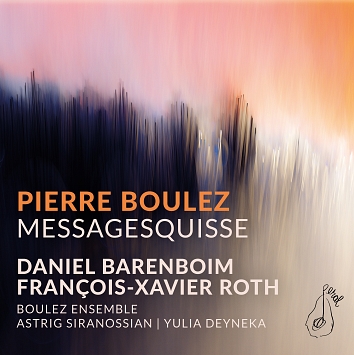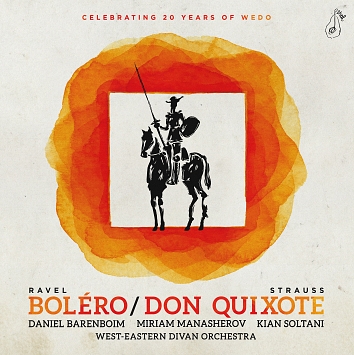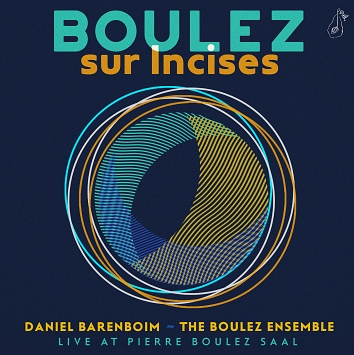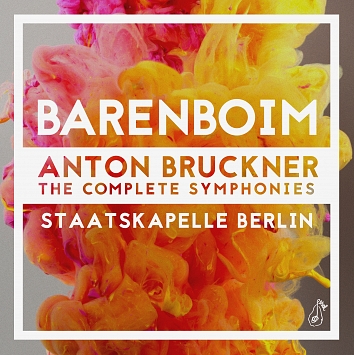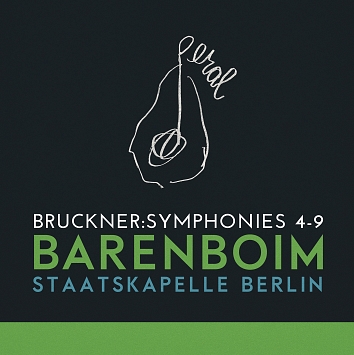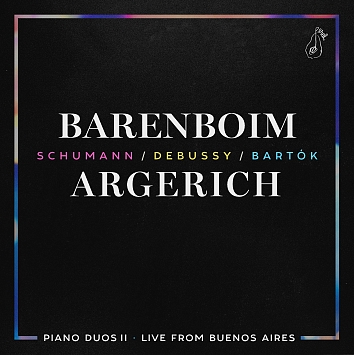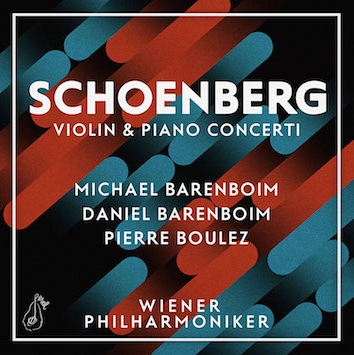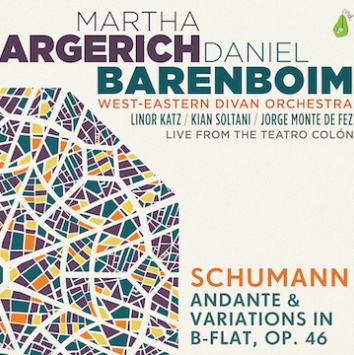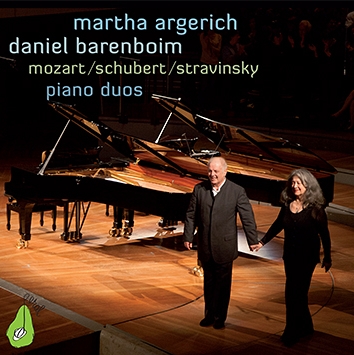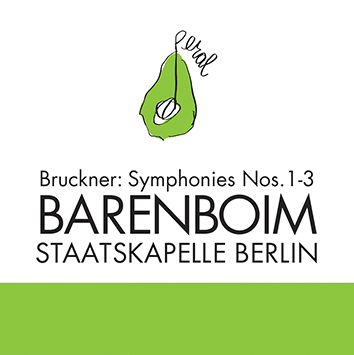Beethoven: Piano Concerto No. 2
Now Available: Peral Music releases a new recording of Beethoven’s Piano Concerto No. 2, featuring the incomparable Martha Argerich and the West-Eastern Divan Orchestra. Peral Music founder Daniel Barenboim conducts.
Beethoven: Violin Concerto
Violinist Michael Barenboim and Peral Music founder Daniel Barenboim join forces once again with the West-Eastern Divan Orchestra, this time to celebrate the music of Beethoven. The composer’s Violin Concerto, recorded during the orchestra’s 20th anniversary year and with Michael Barenboim as the soloist, is now available to stream and download on the Peral Label to mark the Orchestra’s glorious return to live music this summer.
Boulez: Messagesquisse
Peral Music presents two different takes on Boulez‘s groundbreaking Messagesquisse, a 1976 birthday greeting for Paul Sacher. This new 2-track eSingle presents one version for solo cello with Astrig Siranossian and conducted by Daniel Barenboim, followed by another arrangement for solo viola featuring Yulia Deyneka and conducted by François-Xavier Roth, who has been closely associated with the Boulez Ensemble ever since the opening of the Pierre Boulez Saal in Berlin.
Soloists: Astrig Siranossian (cello), Yulia Deyneka (viola)
Conductors: Daniel Barenboim, François-Xavier Roth
Celebrating 20 Years of WEDO
Daniel Barenboim and the West-Eastern Divan Orchestra celebrate the orchestra's twentieth anniversary with performances of Ravel's "Boléro" and Strauss's "Don Quixote." Featuring soloists Kian Soltani (cello) and Miriam Manasherov (viola).
Celebrating 20 Years of WEDO
Track List
Strauss: Don Quixote
- Introduction: Mäßiges Zeitmaß. Thema mäßig. "Don Quichotte verliert über der Lektüre der Ritterromane seinen Verstand und beschließt, selbst fahrender Ritter zu werden" ("Don Quixote loses his sanity after reading novels about knights, and decides to become a knight-errant")
- Theme: Mäßig. "Don Quichotte, der Ritter von der traurigen Gestalt" ("Don Quixote, knight of the sorrowful countenance")
- Maggiore: "Sancho Panza"
- Variation I: Gemächlich. "Abenteuer an den Windmühlen" ("Adventure at the Windmills")
- Variation II: Kriegerisch. "Der siegreiche Kampf gegen das Heer des großen Kaisers Alifanfaron" ("The victorious struggle against the army of the great emperor Alifanfaron") [actually a flock of sheep]
- Variation III: Mäßiges Zeitmaß. "Gespräch zwischen Ritter und Knappen" ("Dialogue between Knight and Squire")
- Variation IV: Etwas breiter. "Unglückliches Abenteuer mit einer Prozession von Büßern" ("Unhappy adventure with a procession of pilgrims")
- Variation V: Sehr langsam. "Die Waffenwache" ("The knight's vigil")
- Variation VI: Schnell. "Begegnung mit Dulzinea" ("The Meeting with Dulcinea")
- Variation VII: Ein wenig ruhiger als vorher. "Der Ritt durch die Luft" ("The Ride through the Air")
- Variation VIII: Gemächlich. "Die unglückliche Fahrt auf dem venezianischen Nachen" ("The unhappy voyage in the enchanted boat")
- Variation IX: Schnell und stürmisch. "Kampf gegen vermeintliche Zauberer" ("Battle with the magicians")
- Variation X: Viel breiter. "Zweikampf mit dem Ritter vom blanken Mond" ("Duel with the knight of the bright moon")
- Finale: Sehr ruhig. "Wieder zur Besinnung gekommen" ("Coming to his senses again" – Death of Don Quixote)
Ravel: Boléro
- Boléro
Boulez: Sur Incises
Daniel Barenboim joins the Boulez Ensemble for a live performance of Boulez's "Sur Incises" at the Pierre Boulez Saal.
Piano: Michael Wendeberg, Karim Said, Denis Kozhukhin
Harp: Aline Khouri, Stephen Fitzpatrick, Susanne Kabalan
Percussion: Dominic Oelze, Lev Loftus, Pedro Torrejón
Bruckner: The Complete Symphonies
"One of the characteristics of the Bruckner symphonies is that the music does not start as being 'here'. It rather becomes. In the later symphonies, you very often feel that this is a kind of delayed action. There’s no music, there are just strings trembling before the music actually starts..."
–Daniel Barenboim
Out now from Peral Music, Bruckner's Complete Symphonies performed by Daniel Barenboim and the Staatskapelle Berlin. Available now, exclusively on Apple Music.
Bruckner: The Complete Symphonies
Track List
Bruckner: The Complete Symphonies
- Bruckner: Symphony No. 1 in C Minor
- Bruckner: Symphony No. 2 in C MInor
- Bruckner: Symphony No. 3 in D Minor
- Bruckner: Symphony No. 4 in E-Flat Major
- Bruckner: Symphony No. 5 in B-Flat Major
- Bruckner: Symphony No. 6 in A Major
- Bruckner: Symphony No. 7 in E Major
- Bruckner: Symphony No. 8 in C Minor
- Bruckner: Symphony No. 9 in D Minor
Bruckner Symphonies 4-9
“You give the concentration, you listen, and if you hang on to the first note, you will travel to fantastic regions in a Bruckner Symphony.” –Daniel Barenboim
Discover Bruckner's symphonies with this release from Peral Music, available exclusively on Apple Music.
Bruckner Symphonies 4-9
Track List
Bruckner: Symphony Nos. 4-9
- Bruckner: Symphony No. 4 in E-Flat Major
- Bruckner: Symphony No. 5 in B-Flat Major
- Bruckner: Symphony No. 6 in A Major
- Bruckner: Symphony No. 7 in E Major
- Bruckner: Symphony No. 8 in C Minor
- Bruckner: Symphony No. 9 in D Minor
Piano Duos II
Legendary pianists Daniel Barenboim and Martha Argerich reunite for Piano Duos II, captured live in Buenos Aires. Listen to Debussy's "En blanc et noir," Schumann's Six Studies in Canon Form, and Bartók's Sonata for Two Pianos and Percussion – available worldwide on October 9, 2015, exclusively on iTunes.
Piano Duos II
Track List
- Schumann: Six Studies in Canon Form: I - Nicht zu schnell
- Schumann: Six Studies in Canon Form: II - Mit innigem Ausdruck
- Schumann: Six Studies in Canon Form: III - Andantino
- Schumann: Six Studies in Canon Form: IV - Innig
- Schumann: Six Studies in Canon Form: V - Nicht zu schnell
- Schumann: Six Studies in Canon Form: VI - Adagio
- Debussy: En blanc et noir: I - Avec emportement
- Debussy: En blanc et noir: II - Lent. Sombre
- Debussy: En blanc et noir: III - Scherzando
- Bartók: Sonata for 2 Pianos: I - Assai lento
- Bartók: Sonata for 2 Pianos: II - Lento, ma non troppo
- Bartók: Sonata for 2 Pianos: III - Allegro non troppo
Live from Teatro Colón
Live from Teatro Colón captures the long-awaited reunion of legendary pianists Daniel Barenboim and Martha Argerich in their home city of Buenos Aires, in concert with the West-Eastern Divan Orchestra.
“"[A] masterly return – a memorable concert – the audience at the Teatro Colón cheered as rarely before.””
La NaciónThe new album comprises Beethoven's First Piano Concerto with Argerich, Mozart's Overture to Le nozze di Figaro, and Ravel's Rapsodie espagnole, Alborada del gracioso, Pavane pour une infante défunte, and Bolero, as well as works by Schumann, Mores, and Bizet.
Live from Teatro Colón
Track List
- Mozart: Overture "Le nozze di Figaro", K.492
- Beethoven: 1. Allegro con brio [Piano Concerto No.1 in C Major, Op.15]
- Beethoven: 2. Largo
- Beethoven: 3. Rondo (Allegro scherzando)
- Schumann: 7. Traumes-Wirren [8 Fantasiestücke, Op.12]
- Ravel: 1. Prélude à la nuit [Rapsodie espagnole M.54]
- Ravel: 2. Malagueña [Rapsodie espagnole M.54]
- Ravel: 3. Habanera [Rapsodie espagnole M.54]
- Ravel: 4. Feria [Rapsodie espagnole M.54]
- Ravel: Alborada del gracioso, M.43
- Ravel: Pavane pour une infante défunte, M.19
- Ravel: Boléro, M.81
- Bizet: Aragonaise [Carmen Suite No.1]
- Bizet: Intermezzo [Carmen Suite No.1]
- Bizet: Les dragons d'Alcala [Carmen Suite No.1]
- Bizet: Les toréadors [Carmen Suite No.1]
- Mores: El Firulete
Schoenberg: Violin & Piano Concerti
Dating from 2005 and 2012, these are the Vienna Philharmonic’s first recordings of two of Schoenberg’s works: the Piano Concerto with Daniel Barenboim under Pierre Boulez and the Violin Concerto with Michael Barenboim under the direction of his father.
The Vienna Philharmonic has enjoyed a close bond with Schoenberg’s music, since he himself conducted two performances of his Gurre-Lieder in 1920 and afterwards wrote a personal letter of thanks, expressing his gratitude to the musicians for their work together. Since then there have been more than 100 performances of his works, and the orchestra even played an important part in the foundation of the Arnold Schoenberg Center in Vienna in 1998.
It is all the harder to believe that the Vienna Philharmonic had never previously played either of these two works.
For Daniel Barenboim the orchestra’s performances of Schoenberg’s music are full of “tenderness, good-natured informality and naturalness.” Their “playing is very much inspired by the venue.”
This makes it all the more inconceivable that these works by arguably the greatest composer of the 20th century, and a native of Vienna to boot, had been overlooked by the orchestra for so many years.
It was not until 2005 that Pierre Boulez conducted the Vienna Philharmonic’s first performance of Schoenberg’s Piano Concerto, when the soloist was Daniel Barenboim. Seven years later Barenboim returned with his son Michael and the two of them gave the first performance of Schoenberg’s Violin Concerto op. 36 with the orchestra. “Highly explosive music,” Michael Barenboim describes Schoenberg’s piece: “Every bar is aflame.” The work’s difficulties are plain. When it received its first performance in 1940, the composer’s daughter, Gertrud Greissle, remarked that “The difficulties are not purely intentional, but they are unavoidable.” Even today the virtuosity of Schoenberg’s Violin Concerto instils a sense of awe in many violinists. For a time Jascha Heifetz regarded the work as unplayable.
But for Barenboim, “Where other orchestras wrestle with the difficulties, the Viennese may do so as well, but they then discover themselves in the music, and this is really wonderful.”
Schoenberg: Violin & Piano Concerti
Track List
- Violin Concerto, Op. 36: I. Poco Allegro
- Violin Concerto, Op. 36: II. Andante grazioso
- Violin Concerto, Op. 36: III. Finale. Allegro
- Concerto for Piano and Orchestra, Op. 42: I. Andante
- Concerto for Piano and Orchestra, Op. 42: II. Molto Allegro
- Concerto for Piano and Orchestra, Op. 42: III. Adagio
- Concerto for Piano and Orchestra, Op. 42: IV. Giocoso (moderato)
Schumann: Andante and Variations
Legendary pianists Daniel Barenboim and Martha Argerich join musicians of the West-Eastern Divan Orchestra for Schumann’s Andante and Variations for two pianos, two cellos and horn op. 46, one of the most beautiful works of Romantic chamber music.
An experiment in coexistence co-founded by Daniel Barenboim and Edward Said, the orchestra brings together musicians from Arab countries and Israel to foster mutual understanding and non-violence through music.
The special performance was part of the inaugural Festival de Música y Reflexión at the Teatro Colón, featuring the West-Eastern Divan Orchestra.
The video release, available exclusively on iTunes, captures a special encore performance that capped off the highly anticipated reunion of the Argentinian musicians on the stage of Buenos Aires’s Teatro Colón.
Argerich & Barenboim: Piano Duos
With roots that trace back to the musical soirées of 1949 Buenos Aires, Martha Argerich and Daniel Barenboim bring their shared love of chamber music to this new release from Peral Music.
Two living legends unite on an extraordinary new release: Argerich and Barenboim performing piano duos by Mozart, Schubert and Stravinsky.
Discover their performances of Mozart’s Sonata in D Major, Schubert’s Variations in A-flat for piano (four hands), and Stravinsky’s Le sacre du printemps.
From Buenos Aires to Berlin
For classical musicians in 1940s Buenos Aires, all roads sooner or later led to No. 1257 Talcahuano. To this house, located in a fashionable residential quarter of the Argentinian capital just north of the city centre, came celebrated international visitors such as Adolf Busch and Arthur Rubinstein, along with local soloists and music students. There, at the home of Ernesto Rosenthal, a Viennese Jewish refugee businessman and amateur violinist, Friday night was chamber music night.
Musicians of all ages attended. Even some very young ones came too, attracted by Mrs. Rosenthal’s homemade apfelstrudel as well as by the music. So it was, in 1949, that Aida Barenboim brought her seven-year-old son Danielito along to a Rosenthal evening for the first time. So it was also that Juanita Argerich similarly brought her eight-year-old daughter Marthita to the Rosenthals. “We sight-read and played with whomever was in town,” Daniel Barenboim remembers. “We were the two little wunderkinder,” recalls Martha Argerich. “We played children’s games under the table,” says Barenboim. “I used to hide, but he would find me,” Argerich laughs.
Astonishingly, in view of what these two child talents were later to become in the keyboard world, the two great Buenos Aires-born pianists do not seem to have ever played at the piano together at those now distant Rosenthal chamber music evenings. Even so, more than 60 years later, Daniel Barenboim remembers listening to his eight-year-old friend playing Chopin’s C sharp minor Étude from op. 10 “with exactly the same fire and brilliance that she plays it with today”. Martha Argerich just remembers that “Daniel played everything. His enormous repertoire was already amazing. My mother used to say, ‘Oh, why can’t you be like Daniel?’”
In due course the two budding virtuosos left Buenos Aires to conquer the wider musical world. Barenboim was the first to leave Argentina, in 1952. Argerich did not follow until 1955. Their careers took separate but equally stellar paths. From a distance, they watched one another as they became among the most revered musicians of their era. Occasionally their paths would cross, at masterclasses in Salzburg, for example, and especially in London in the 1960s. But it was not until the 1980s, when Barenboim was music director of the Orchestre de Paris, that Argerich did a series of dates with her fellow porteño. Argerich played Liszt’s Second Piano Concerto under Barenboim’s direction, and he persuaded her to learn Falla’s Nights in the Gardens of Spain. It was also in Paris, during roughly the same period, that Barenboim and Argerich finally gave a four-handed recital together for the first time, in a programme that included works by Schubert and Liszt.
But then their paths diverged again. Each had their own separate musical projects. Argerich had a period of illness. Barenboim was preoccupied with his conducting. And then, in 2013, Barenboim suggested another reunion, this time in Berlin, as part of the 2014 Festtage – the spring festival that Barenboim has organised in the German capital city every year since 1996. He proposed a programme of music for four hands, some of it played on two pianos, some at one piano. Argerich thought about it and accepted. The result was one of the most nervously anticipated recitals of modern times, as the two legendary pianists reunited in Berlin’s Philharmonie on the afternoon of Saturday 19 April 2014. Argerich arrived in Berlin a week before the recital, and rehearsals took place most days in the run-up to the performance.
The programme was the result of friendly negotiations between the two pianists. “We always speak in Spanish – well, Argentinian!” says Barenboim. Mozart was an obvious choice. “I am completely crazy about Daniel’s Mozart playing,” says Argerich. “He is like a singer in every phrase, but for me Mozart is difficult and I was nervous about it.” Argerich had played the D major Sonata for Two Pianos before, but when Barenboim suggested that the sonata should be played with a very controlled dynamic, it suddenly sounded right. The two pianists played the Mozart side by side, Barenboim’s piano closer to the front of the platform and Argerich’s at the back. Schubert’s Variations on an Original Theme in A flat major had been part of the Barenboim–Argerich programme all those years before in Paris. Now, with one piano wheeled temporarily to the wings, the two sat side by side at the one instrument. Argerich chose to play the bottom part. “She is a wonderful accompanist,” says Barenboim, “and I think she also wanted to control the pedals and the balance.”
But it was the second part of the programme that clinched the deal for the Barenboim and Argerich reunion and that most of the audience had probably come to hear. Prior to the premiere of Le Sacre du Printemps, Stravinsky had himself prepared a four-hand piano arrangement of the orchestral score – and even gave an early private performance of it with his friend Claude Debussy – but Argerich had never played it before. She learnt the score specially for the Berlin recital. “I didn’t feel inhibited by the difficulties, though it certainly is difficult, rhythmically in particular,” she says. “But I think it worked. We were very happy with it.”
The audience reception for their brilliant and blistering playing was wildly enthusiastic. And it was shared by Argerich’s platform partner. “I have been conducting this piece for many years,” says Barenboim. “It is a very slippery affair. In an orchestral performance, someone in the orchestra is always insecure at some point, with an imperfect tone or rhythm. Someone always makes an error. But this was the first time Martha had played it. And she made absolutely no mistakes at all. I was flabbergasted.” Sitting in the hall, one was bound to agree. It was as though the long artistic journeys that began in those musical soirées in Buenos Aires back in 1949 had finally reached a long-deferred but somehow always predestined meeting-point.
Martin Kettle
Argerich & Barenboim: Piano Duos
Track List
- Mozart: Sonata in D Major for 2 Pianos, K.448 1. Allegro con spirito
- Mozart: Sonata in D Major for 2 Pianos, K.448 2. Andante
- Mozart: Sonata in D Major for 2 Pianos, K.448 3. Allegro molto
- Schubert: Variations On A Original Theme In A Flat, D813
- Stravinsky: Part 1: The Adoration of the Earth [Le Sacre du Printemps - Version for Piano Duet)
- Stravinsky: Part 2: The Sacrifice [Le Sacre du Printemps - Version for Piano Duet]
Bruckner Symphonies 1-3
Orchestras that play operatic repertoire, particularly the music of Wagner, bring something special to Bruckner’s music.
“One feature of Bruckner’s symphonies that has been consistently held in my interest is that they sound as if they were conceived over the course of many centuries. The harmonic work is from the 19th century; the form is a Baroque form, 17th century. But there’s something medieval in the atmosphere, in the psychology of the music. And one often talks about the architecture of the music; but with Bruckner, sometimes I have the feeling that it goes deeper and deeper, more like an archaeological expedition rather than an architectural building.”
Daniel BarenboimListen for it in this new recording with the Staatskapelle Berlin.
Bruckner Symphonies 1-3
Track List
Symphony No. 1 in C Minor
- Allegro molto moderato
- Adagio
- Scherzo. Lebhaft
- Finale. Bewegt und feurig
Symphony No. 2 in C Minor
- Ziemlich schnell
- Adagio. Feierlich, etwas bewegt
- Scherzo. Schnell
- Finale. Mehr schnell - Sehr schnell
Symphony No. 3 in D Minor
- Gemässigt, mehr bewegt, Misterioso
- Adagio, bewegt, quasi Andante
- Scherzo (Ziemlich schnell)
- Finale (Allegro)
.jpg)
.jpg)

